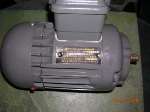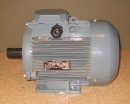How to choose an electric motor according to the degree of protection
The basic principles of the classification of electric motors and other electrical equipment, as well as the classification of explosion safety, are universal in all countries of the world. They are based on the recommendations of the International Electrotechnical Commission (IEC). And although the standards in different countries have different names, their approaches and classification methods are practically the same.
In accordance with regulatory documents (GOST 14254-80), electrical equipment must be assigned to an appropriate degree of protection… The abbreviation «IP» is used to indicate the degree of protection. Then comes a two-digit numerical designation… The letter X can also be used instead of numbers if the degree is not specified. What is behind these numbers? In accordance with GOST, 7 degrees are established, from 0 to 6, from the penetration of solid particles and from 0 to 8 from the penetration of liquid.
All electric motors according to the method of protection against environmental influences, it can have the following design:
 Protected - having a device (nets or perforated shields on the end shields) to protect against accidental contact with rotating parts and live parts, as well as to prevent the ingress of foreign objects, except for dust, fibers, splashes of water, etc. Electrical equipment is cooled by ambient air... IP21, IP22 (not lower)
Protected - having a device (nets or perforated shields on the end shields) to protect against accidental contact with rotating parts and live parts, as well as to prevent the ingress of foreign objects, except for dust, fibers, splashes of water, etc. Electrical equipment is cooled by ambient air... IP21, IP22 (not lower)
Blown - the cooling air (or inert gas) enters inside from its own or specially installed fan through pipes connected to the pipes of the equipment. If the cooling agent is removed outside the room, the blown machines are closed in that room.
Splash-resistant - with a device that prevents the penetration of water drops falling vertically, as well as at an angle of 45 ° to the vertical on each side, but does not protect against the penetration of dust, fibers, etc. IP23, IP24
Closed - the internal cavity of the equipment is separated from the external environment by a shell that prevents the penetration of fibers, large dust, water drops, the electrical equipment is cooled due to the ribbed surface of the case. IP44-IP54
Closed blown - the equipment is equipped with a ventilation device for blowing its external surfaces. Air is supplied by a fan located outside the machine and protected by a cover. To mix the air inside the machine, blades are thrown on its rotor or an internal fan is installed. IP44-IP54
Dustproof - Electric motors and devices have an enclosure that is sealed in such a way that it does not allow fine dust to penetrate inside. IP65, IP66
Sealed (with particularly dense isolation from the environment) — IP67, IP68.
In addition to the degree of protection for the correct selection of electrical equipment, the following conditions must also be taken into account:
1 — climatic version;
2 — place (category) of placement;
3 — specific working conditions (danger of explosion, chemically aggressive environment).
Climatic characteristics are determined by GOST 15150-69. In accordance with the climatic conditions, it is denoted by the following letters: У (N) — moderate climate; CL (NF) — cold climate; TV (TN) — tropical humid climate; TS (TA) — tropical dry climate; O (U) — all climatic regions, on land, rivers and lakes; M — moderate maritime climate; OM — all areas of the sea; B — all macroclimatic regions on land and in the sea.
 Accommodation categories: 1 — outdoors; 2 — premises in which fluctuations in temperature and humidity do not differ significantly from fluctuations in the open air; 3 — closed premises with natural ventilation without artificial regulation of climatic conditions (no influence of sand and dust, sun and water (rain)); 4 — premises with artificial regulation of climatic conditions (no impact of sand and dust, sun and water (rain), outside air); 5 — rooms with high humidity (prolonged presence of water or condensed moisture).
Accommodation categories: 1 — outdoors; 2 — premises in which fluctuations in temperature and humidity do not differ significantly from fluctuations in the open air; 3 — closed premises with natural ventilation without artificial regulation of climatic conditions (no influence of sand and dust, sun and water (rain)); 4 — premises with artificial regulation of climatic conditions (no impact of sand and dust, sun and water (rain), outside air); 5 — rooms with high humidity (prolonged presence of water or condensed moisture).
The climatic version and the placement category are entered in the type designation of the electrical product.
If the selected electric motors are to work in potentially explosive areas, they must be of explosion-proof design.
 Here it is important to understand the difference between the concepts of "environmental protection" and "explosion protection".if in the first case our electric motors (and other electrical equipment) are protected from the negative impact of water and dust on it, then in the case of explosion protection the environment is protected by our electric motor.
Here it is important to understand the difference between the concepts of "environmental protection" and "explosion protection".if in the first case our electric motors (and other electrical equipment) are protected from the negative impact of water and dust on it, then in the case of explosion protection the environment is protected by our electric motor.
Explosion-proof electrical product (electrical device, electrical equipment) — an electrical product (electrical device, electrical equipment) for special purposes, which is made in such a way that the possibility of igniting the surrounding explosive environment due to the operation of this product is eliminated or prevented (GOST 18311 -80).
Explosion-proof equipment ensures the safety of its use in explosive premises and outdoor installations, that is, by the correct selection of the same electric motor in terms of explosion protection, we create conditions where sparks, various local overheating, etc., inside the electric motor are reliably enclosed by a shell and other devices from the environment. In this case, our electric motor cannot cause an explosion.
The explosion protection levels of electrical equipment are designated 0, 1 and 2 in the classification:
Level 0 — highly explosion-proof equipment in which special measures and means of explosion protection are applied,
Level 1 - explosion-proof electrical equipment: explosion protection is provided both under normal operating conditions and in the event of probable damage depending on the operating conditions, with the exception of damage to explosion-proof means,
Level 2 — electrical equipment with increased reliability against explosion: in it, explosion protection is provided only during normal operation.
